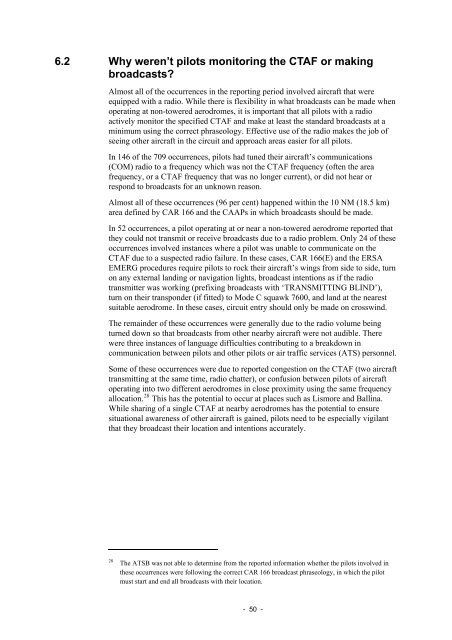Safety in the vicinity of non-towered aerodromes - Australian ...
Safety in the vicinity of non-towered aerodromes - Australian ...
Safety in the vicinity of non-towered aerodromes - Australian ...
Create successful ePaper yourself
Turn your PDF publications into a flip-book with our unique Google optimized e-Paper software.
6.2 Why weren’t pilots monitor<strong>in</strong>g <strong>the</strong> CTAF or mak<strong>in</strong>g<br />
broadcasts?<br />
Almost all <strong>of</strong> <strong>the</strong> occurrences <strong>in</strong> <strong>the</strong> report<strong>in</strong>g period <strong>in</strong>volved aircraft that were<br />
equipped with a radio. While <strong>the</strong>re is flexibility <strong>in</strong> what broadcasts can be made when<br />
operat<strong>in</strong>g at <strong>non</strong>-<strong>towered</strong> <strong>aerodromes</strong>, it is important that all pilots with a radio<br />
actively monitor <strong>the</strong> specified CTAF and make at least <strong>the</strong> standard broadcasts at a<br />
m<strong>in</strong>imum us<strong>in</strong>g <strong>the</strong> correct phraseology. Effective use <strong>of</strong> <strong>the</strong> radio makes <strong>the</strong> job <strong>of</strong><br />
see<strong>in</strong>g o<strong>the</strong>r aircraft <strong>in</strong> <strong>the</strong> circuit and approach areas easier for all pilots.<br />
In 146 <strong>of</strong> <strong>the</strong> 709 occurrences, pilots had tuned <strong>the</strong>ir aircraft’s communications<br />
(COM) radio to a frequency which was not <strong>the</strong> CTAF frequency (<strong>of</strong>ten <strong>the</strong> area<br />
frequency, or a CTAF frequency that was no longer current), or did not hear or<br />
respond to broadcasts for an unknown reason.<br />
Almost all <strong>of</strong> <strong>the</strong>se occurrences (96 per cent) happened with<strong>in</strong> <strong>the</strong> 10 NM (18.5 km)<br />
area def<strong>in</strong>ed by CAR 166 and <strong>the</strong> CAAPs <strong>in</strong> which broadcasts should be made.<br />
In 52 occurrences, a pilot operat<strong>in</strong>g at or near a <strong>non</strong>-<strong>towered</strong> aerodrome reported that<br />
<strong>the</strong>y could not transmit or receive broadcasts due to a radio problem. Only 24 <strong>of</strong> <strong>the</strong>se<br />
occurrences <strong>in</strong>volved <strong>in</strong>stances where a pilot was unable to communicate on <strong>the</strong><br />
CTAF due to a suspected radio failure. In <strong>the</strong>se cases, CAR 166(E) and <strong>the</strong> ERSA<br />
EMERG procedures require pilots to rock <strong>the</strong>ir aircraft’s w<strong>in</strong>gs from side to side, turn<br />
on any external land<strong>in</strong>g or navigation lights, broadcast <strong>in</strong>tentions as if <strong>the</strong> radio<br />
transmitter was work<strong>in</strong>g (prefix<strong>in</strong>g broadcasts with ‘TRANSMITTING BLIND’),<br />
turn on <strong>the</strong>ir transponder (if fitted) to Mode C squawk 7600, and land at <strong>the</strong> nearest<br />
suitable aerodrome. In <strong>the</strong>se cases, circuit entry should only be made on crossw<strong>in</strong>d.<br />
The rema<strong>in</strong>der <strong>of</strong> <strong>the</strong>se occurrences were generally due to <strong>the</strong> radio volume be<strong>in</strong>g<br />
turned down so that broadcasts from o<strong>the</strong>r nearby aircraft were not audible. There<br />
were three <strong>in</strong>stances <strong>of</strong> language difficulties contribut<strong>in</strong>g to a breakdown <strong>in</strong><br />
communication between pilots and o<strong>the</strong>r pilots or air traffic services (ATS) personnel.<br />
Some <strong>of</strong> <strong>the</strong>se occurrences were due to reported congestion on <strong>the</strong> CTAF (two aircraft<br />
transmitt<strong>in</strong>g at <strong>the</strong> same time, radio chatter), or confusion between pilots <strong>of</strong> aircraft<br />
operat<strong>in</strong>g <strong>in</strong>to two different <strong>aerodromes</strong> <strong>in</strong> close proximity us<strong>in</strong>g <strong>the</strong> same frequency<br />
allocation. 28 This has <strong>the</strong> potential to occur at places such as Lismore and Ball<strong>in</strong>a.<br />
While shar<strong>in</strong>g <strong>of</strong> a s<strong>in</strong>gle CTAF at nearby <strong>aerodromes</strong> has <strong>the</strong> potential to ensure<br />
situational awareness <strong>of</strong> o<strong>the</strong>r aircraft is ga<strong>in</strong>ed, pilots need to be especially vigilant<br />
that <strong>the</strong>y broadcast <strong>the</strong>ir location and <strong>in</strong>tentions accurately.<br />
28 The ATSB was not able to determ<strong>in</strong>e from <strong>the</strong> reported <strong>in</strong>formation whe<strong>the</strong>r <strong>the</strong> pilots <strong>in</strong>volved <strong>in</strong><br />
<strong>the</strong>se occurrences were follow<strong>in</strong>g <strong>the</strong> correct CAR 166 broadcast phraseology, <strong>in</strong> which <strong>the</strong> pilot<br />
must start and end all broadcasts with <strong>the</strong>ir location.<br />
- 50 -
















